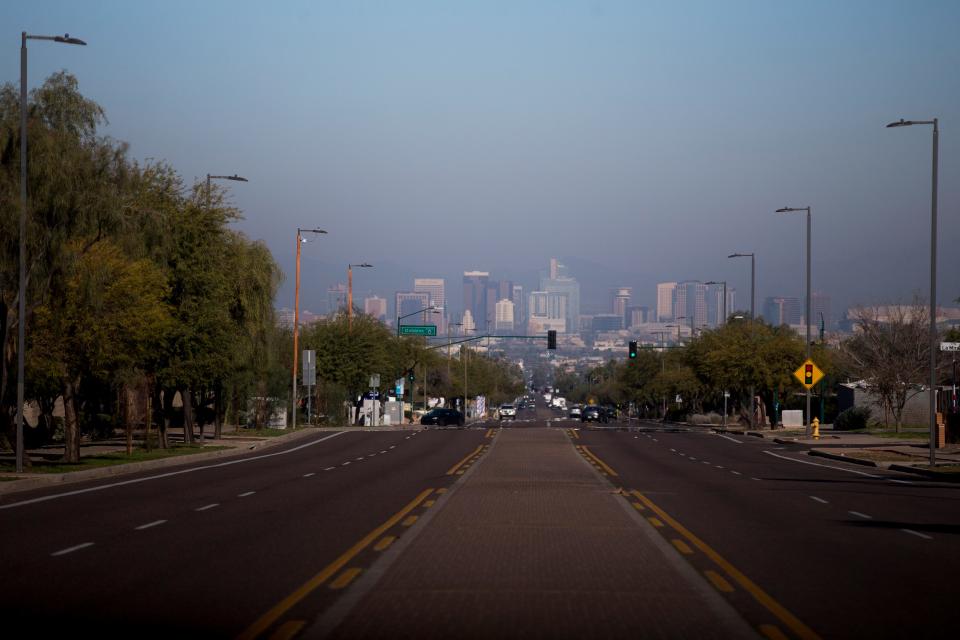Phoenix ranks 5th in ozone pollution, but a new report finds fewer bad air days overall
Ozone levels in Phoenix were the fifth-worst in the nation over a three-year span, according to the American Lung Association’s 2023 State of the Air Report, but there were fewer overall unhealthy days in Arizona.
The Lung Association’s 24th annual “State of the Air” report grades Americans’ exposure to unhealthy levels of ground-level ozone air pollution, annual particle pollution and short-term spikes in particle pollution over a three-year period. This year’s report covers 2019-2021 and found one in three Americans are exposed to unhealthy levels of air pollution.
Phoenix ranked seventh for worst annual particle pollution in this year's report and 13th for short-term (24-hour) particle pollution.
The Lung Association developed its annual report rankings using air quality data for the two most widespread pollutants in the United States — ozone and fine particulate matter. These pollutants pose a public health concern when they reach unhealthy levels.
“Both ozone and particle pollution can cause premature death and other serious health effects such as asthma attacks, cardiovascular damage, and developmental and reproductive harm,” said JoAnna Strother, senior director of advocacy for the American Lung Association in Arizona. “Particle pollution can also cause lung cancer. To ensure a healthy future for Arizonans and visitors to our great state, we must continue our work together to improve air quality.”
Short-term exposure to fine particle matter can aggravate lung disease, trigger asthma attacks and bronchitis and can increase the risk of respiratory infections. Long-term exposure to polluted air can have permanent health effects, including the accelerated aging of the lungs, which can lead to loss of lung capacity and decreased lung function.
Long-term exposure to air pollution is also linked to cardiovascular disease and is believed to increase the risk of stroke by hardening arteries in the brain. This makes blood thicker and raises blood pressure, boosting the risk of clots in the brain.
Fewer unhealthy days, but room for improvement

The newest report shows Arizona had fewer unhealthy days for ozone and particle pollution compared with last year’s report.
“As a Southwestern desert state with the sunniest cities in the country and increasing wildfires in the Western U.S., Arizona, like our neighboring states, shares real air quality challenges when it comes to ozone and particle pollution,” said Daniel Czecholinski, air quality division director for the Arizona Department of Environmental Quality. “While we’ve achieved significant improvements in overall air quality over the last 30 years from a 70 percent reduction in emissions — even as Arizona’s population has grown and our economy thrived — more wildfires in the Western U.S. create and transport more ozone and particle pollution into the state, which affects our air quality.”
And while overall air quality has improved in recent decades, climate change, wildfires and ozone transport still are major risks for public health in the state.
Phoenix’s ranking from the previous year for ozone remained the same. Also unchanged from last year’s report for the number of high ozone days is the grade of “F” for Gila, Maricopa, Pima and Pinal counties and the grade of “C” for Yuma County. The report shows improved ozone grades for Coconino and La Paz counties, and noted that Flagstaff is one of the country’s cleanest cities for ozone pollution.
Neighboring states can contribute
Ground-level ozone pollution is created when nitrogen oxides and volatile organic compounds chemically react in sunlight. On average, Arizona has more sunlight and less cloud cover than any other state in the nation, making the state vulnerable to poor air quality. High summer temperatures raise ozone levels.
Compounds that form ozone also come from biomass (shrubs and trees), industry, wildfires, gas-powered garden equipment and more.
Emissions from international sources and other states, like California, likely play a role in Arizona’s ozone pollution. ADEQ says it's working with the neighboring states to better understand ozone transport to improve air quality for everyone.
According to ADEQ, vehicles on roadways produce the majority of nitrogen oxide and are the biggest contributor to human-caused ozone.
The “State of the Air” report relies on data from air quality monitors managed by state, local and tribal air pollution control authorities in counties across the U.S. Out of the 3,221 counties across the entire U.S., only 922 counties can monitor for at least one pollutant. That means that thereare more than 71 million people who live in counties where their ozone and particle pollution levels are not being monitored.
The American Lung Association used the report to call on the federal government to take steps to clean up air pollution nationwide with measures like new limits on ozone and particle pollution and new regulations on power plants and vehicles.
Jake Frederico covers environmental issues for The Arizona Republic and azcentral. Send tips or questions to jake.frederico@arizonarepublic.com.
Environmental coverage on azcentral.com and in The Arizona Republic is supported by a grant from the Nina Mason Pulliam Charitable Trust. Follow The Republic environmental reporting team at environment.azcentral.com and @azcenvironment on Facebook, Twitter and Instagram.
You can support environmental journalism in Arizona by subscribing to azcentral today.
This article originally appeared on Arizona Republic: Phoenix ranks 5th in ozone pollution, but report sees improvement

